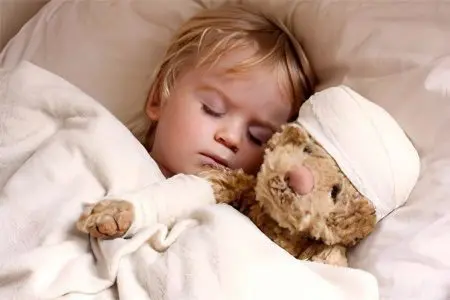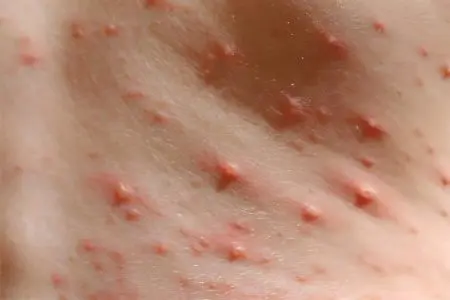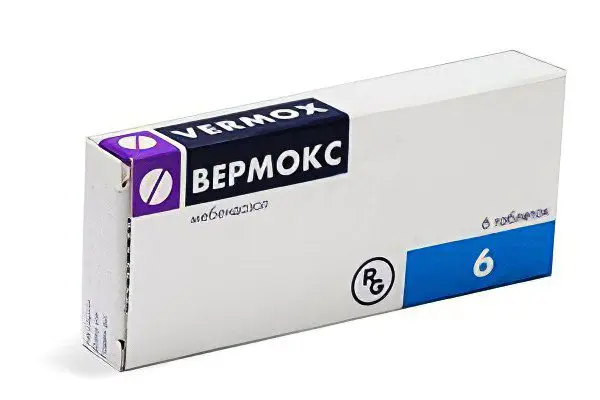Contents

Toxocariasis in children is a zoonotic helminthiasis, which is manifested by damage to the internal organs and eyes by nematode larvae migrating through the body. The disease is provoked by the toxocara worm (Toxocara canis). Worms have an elongated body resembling a cylinder, pointed at both ends. Females can reach 10 cm in length, and males 6 cm.
Adult individuals parasitize in the body of dogs, wolves, jackals and other canids, less often Toxocara are found in the body of cats. Animals release eggs into the environment, which after a certain time become invasive, after which they somehow enter the body of a mammal and migrate through it, causing symptoms of the disease. Toxocariasis, according to the classification of helminthiases, belongs to geohelminthiases, since eggs with larvae are preparing for invasion in the soil.
Toxocariasis in children is manifested by a wide variety of symptoms that even experienced doctors are sometimes unable to make a diagnosis based on the clinical picture of the disease. The fact is that the larvae can penetrate into almost any organ of the child, as they migrate through the blood vessels. Depending on which organ is affected, the symptoms of the disease differ.
However, always with toxocariasis, children develop allergic reactions such as urticaria or bronchial asthma. In severe cases, Quincke’s edema is observed.
Toxocariasis is widely distributed among children under 14 years of age living in rural areas. In the high-risk zone, children from 3 to 5 years. The disease can last for years, and parents will unsuccessfully treat the child for a variety of pathologies. Only adequate antiparasitic therapy will save children from many health problems.
Causes of toxocariasis in children

The source of infection is most often dogs. Puppies have the greatest epidemiological significance in terms of infection transmission. The causative agent of toxocariasis in cats is very rare.
Parasites in appearance strongly resemble human roundworms, as they belong to the same group of helminths. Both toxocars and roundworms have a similar structure, a similar life cycle. However, the definitive host in Ascaris is a human, while in Toxocara it is a dog. Therefore, the symptoms of the disease vary.
If parasites enter the body of a person who is an accidental host for them, then they provoke severe damage to internal organs, since they are unable to exist normally in his body. Larvae cannot adequately complete their life cycle and turn into a sexually mature individual.
Toxocars enter the body of animals (cats and dogs) through the gastrointestinal tract, most often this occurs when eating other infected mammals, when eating feces with larvae, during prenatal development of puppies (larvae are able to penetrate the placenta), or when puppies are breastfed by a sick mother. Under the influence of the gastric environment, the larvae are released from their shell, penetrate through the blood into the liver, into the inferior vena cava, into the right atrium and into the lungs. Then they rise into the trachea, into the larynx, into the throat, are again swallowed with saliva, again enter the gastrointestinal tract, where they reach puberty. It is in the small intestine of cats and dogs that Toxocara live, parasitize and multiply. Their eggs are excreted along with faeces into the external environment and after a certain time become ready for invasion.
Infection of children with toxocariasis occurs as follows:
The child swallows the eggs of the worm from the fur of the animal.
The child eats foodstuffs contaminated with Toxocara eggs (most often fruits, vegetables, berries, herbs).
The child eats soil (most often sand) with toxocara eggs. Mostly this happens during games in the sandbox and is due to the age characteristics of children.
Cockroaches pose a particular danger in terms of transmitting toxocariasis to humans. They eat worm eggs and excrete them in people’s homes, often seeding human food with their feces with viable eggs. This can lead to infection in humans.
Pigs, chickens, lambs can act as reservoir animals for toxocar larvae. Therefore, a child can become infected by eating infected meat.
It is young children who most often become infected with toxocariasis, since they have poorly formed personal hygiene rules. The peak of invasion falls on the warm season, when human contacts with the earth become more frequent.
Once in the body of a child, toxocara larvae penetrate into the systemic circulation and settle in a variety of organs. Since the human body is an unsuitable environment for toxocara, the larva is enveloped in a dense capsule and in this form it will be inactive for a long time. In this state, parasite larvae can exist for many years. At the same time, the child’s immune system does not allow her to move on, constantly attacking a foreign organism. As a result, in the place where the parasite stopped, chronic inflammation occurs. If the immune system weakens, the worm becomes active and the disease worsens.
Symptoms of toxocariasis in children

Symptoms of toxocariasis in children under the age of 12 are most often pronounced, sometimes the disease takes a severe course. At an older age, the symptoms of the disease may be erased, or the complete absence of complaints from the patient.
Symptoms of toxocariasis in children should be considered through the form of the disease, that is, depending on which organ is affected by the parasite:
Visceral toxocariasis in children with damage to internal organs. Since the larvae of the worm move through the body through the veins, they most often settle in those organs that are well supplied with blood, but the blood flow in them is not strong. Mostly it is the lungs, liver and brain.
Considering the defeat of the digestive organs of the child (liver, biliary tract, pancreas, intestines) by Toxocar larvae, the following symptoms can be distinguished:
Pain in the right hypochondrium, in the abdomen, in the navel.
Appetite disorders.
Bloating.
Bitterness in the mouth.
Frequent change of diarrhea and constipation.
Nausea and vomiting.
Loss of body weight, lag in physical development.
If toxocars affect the lungs, then the child develops characteristic broncho-pulmonary symptoms with a dry cough, shortness of breath, and difficulty breathing. The development of bronchial asthma is not ruled out. There is evidence of the manifestation of pneumonia, which ended in death.
If the larvae settle on the heart valves, then this leads to the development of heart failure in the patient. The child has blue skin, lower and upper limbs, nasolabial triangle. Even at rest, shortness of breath and coughing occur. With the defeat of the right half of the heart, severe edema appears on the legs. This condition requires emergency hospitalization.
Ocular toxocariasis in children. The organs of vision are rarely affected by toxocara larvae, this is manifested by loss of vision, conjunctival hyperemia, bulging of the eyeball, and pain in the eye. Most often one eye is affected.
Cutaneous toxocariasis in children. If the larvae enter the dermis of the child, then this is manifested by severe itching, burning, a feeling of movement under the skin. In the place where the larva stops, as a rule, persistent inflammation occurs.
Neurological toxocariasis in children. If the toxocara larva has penetrated the meninges, then the disease manifests itself with characteristic neurological symptoms: behavioral disorders, loss of balance, headaches, sleep disturbances, dizziness, symptoms of focal brain damage (convulsions, paralysis, paresis, etc.).
Regardless of where the larva stops, the immune system begins to attack it, which leads to the development of allergic reactions:

Skin rash. Most often, it resembles mosquito bites and has the shape of a ring. The rash is intensely itchy and can occur almost anywhere on the body.
Quincke’s edema. This condition is characterized by swelling of the soft tissues in the neck. With a pronounced reaction, an asthma attack may occur, which, if proper assistance is not provided, will lead to the death of the child.
Bronchial asthma. The child is constantly coughing. The cough has a dry character, sputum is separated in small quantities. During the attack, strong wheezing and noisy breathing are heard.
Common symptoms of toxocariasis in children are:
An increase in body temperature to 37-38 ° C and above, a feverish state.
Intoxication of the body with weakness, headaches, loss of appetite.
Enlargement of the lymph nodes in size, while they do not hurt and remain mobile.
Pulmonary syndrome with persistent dry cough.
Enlargement of the spleen and liver in size.
Violation of the intestinal microflora.
Frequent infections associated with immunosuppression.
Diagnosis of toxocariasis in children

Diagnosis of toxocariasis in children is very difficult, since the symptoms of the disease are very difficult to distinguish from diseases of other organs. That is why such children have been unsuccessfully treated by gastroenterologists, pulmonologists and other narrow specialists for a long time. Pediatricians classify such children as frequently ill.
Parasitic invasion can be suspected by an increase in eosinophils in the blood (they are responsible for antiparasitic immunity) and by an increase in total immunoglobulin E.
Sometimes Toxocara larvae can be found in sputum during microscopic examination. However, the most informative method to detect this parasitic invasion is ELISA with the extrasecretory antigen of Toxocara larvae.
Treatment of toxocariasis in children

Treatment of toxocariasis in children begins with the administration of anthelmintic drugs.
Most often, the child is prescribed one of the following medicines:
Mintezol. The course of treatment can be 5-10 days.
Vermox. The course of treatment can last from 14 to 28 days.
dithrazine citrate. The drug is taken for 2-4 weeks.
Albendazole. A full course can last from 10 to 20 days.
In addition, the child needs to normalize the intestinal microflora. To do this, he is prescribed probiotics Linex, Bifiform, Bifidum forte, etc. In order to remove toxins from the intestines, adsorbents are prescribed, for example, Smektu or Enterol.
Symptomatic therapy is reduced to taking antipyretic drugs (Paracetamol, Ibuprofen). With severe pain in the abdomen, it is possible to prescribe Papaverine. To eliminate allergic reactions, the child is prescribed antihistamines, including Zirtek, Zodak, etc. Glucocorticosteroids are administered in severe cases of the disease with severe allergic reactions. The same applies to electrolyte solutions that are administered intravenously in a hospital to reduce the symptoms of intoxication.
Be sure to prescribe hepatoprotectors to children, which allow to restore the functioning of the liver. If there is a need, then not only a parasitologist, pediatrician and infectious disease specialist, but also a neurologist, ophthalmologist, and surgeon are involved in the work.
When the symptoms of the disease are acute, the placement of the child in a hospital is indicated.
In addition to taking medications, the child is transferred to a special diet, removing from the menu all products that could cause an allergic reaction. These are chocolate, citrus fruits, spices, smoked meats, etc.
When the child is discharged from the hospital, he is observed by a pediatrician for another year, visiting him every 2 months. Depending on the severity of the disease, children are not vaccinated for 1-3 months. For the same period they are given a medical exemption from physical education.
As a rule, the prognosis for toxocariasis in children is favorable, damage to the heart, brain and eyes is rare. However, it is very dangerous to delay with adequate therapy.









